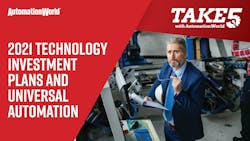Automation Investment Trends in Discrete Manufacturing | Schneider Electric Calls for Universal Automation

Quick hits:
- Discover the top 5 areas for 2021 technology investments in the discrete manufacturing industries
- Why some common automation technologies are expected to see lower investments in 2021.
- Learn about the connection between “universal automation” and the IEC 61499 standard.
- Find out why Schneider Electric says its EcoStruxure Automation Expert version 21.0 is "the first software-centric industrial automation system.”
Related to this episode:
- Automation World's feature story on automation expectations for discrete manufacturing.
- Report on Schneider Electrics' call for greater cooperation around interoperability.
- Learn about PMMI's OpX leadership network and how it provides solutions for the industry's most pressing challenges.
Thanks for joining me for Take Five with Automation World. I'm David Greenfield, the Director of Content for Automation World. And in this episode, I want to highlight two recent developments in the world of industrial automation that you should be aware of.
The first of these involves insight into where spending is being focused on automation technologies across the discrete manufacturing industries. Having insights into this kind of information, not only helps highlight where the industry at large is focusing, but it also helps direct new technology assessments of your own operations to better understand where you stand in respect to your peers. Now, as part of a study that Automation World recently conducted on automation technology spending, we surveyed technology suppliers to get insights into where they saw technology investments being made and plan for in 2020. Which as we all know was a year that really shook up industry due to the impact of COVID-19 on everything from greater levels of remote work, social distancing requirements in factories, and the increased use of remote access technologies.Now from this research that we conducted, we learned that technology suppliers expect the following technologies to be the top five areas for targeted spending in 2021. And those are data acquisition and analytics, cloud computing, cybersecurity software, IOT platform software, and sensors. Now, in one sense, you could say that this represents a continuation of the spending trends we've seen over the past several years now. But you can also see how it represents an increased focus on the digital transformation of industry, considering that each of these five technologies are central to the Industrial Internet of Things and Industry 4.0.
Now, I say this because while all suppliers responding to our survey, see only increased spending in these categories, those same suppliers are projecting some downturn in spending in many well-known technology categories, such as controllers, ERP, HMI SCADA, IO and manufacturing execution systems. But with that said, some suppliers expect a slight downturn and spending for a few Industry 4.0 technologies in 2021 too. Such as remote access and monitoring, edge computing, and simulation and digital twin technologies. Now, I should note here that while these areas are expected to see a decrease according to some suppliers, the expected decreases they're forecasting are not significant, they're typically in the low single digits, and suppliers still expect overall growth from these technology areas. The forecast of suppliers who are expecting slight downturns likely reflect a slight downturn from higher levels of investment they've seen over the past few years. To read more about this, visit the link here.
Now, the other development that I want to highlight in this episode is the call for greater technology supplier cooperation around system and device interoperability that was made by Schneider Electric during this year's ARC forum. John Conway, who's the vice president of strategy and partnerships at Schneider Electric, said the company is calling on all stakeholders across industry to embrace this concept of universal automation. He described this term as referencing plug and produce automation software components based on the IEC-61499 standard. He said that adoption of a universal automation layer based on this standard can provide, “limitless opportunities for growth and modernization across industry.” Now, I should mention here that Schneider Electric is currently working with the Open Process Automation Forum and other technology vendors around use of IEC-61499. Companies also working with ZVEI, the German Electrical and Electronic Vendor Association, around the development of modular distributed software systems with several other major vendors involved.
Now, an interesting note about this call for greater cooperation around universal automation was Schneider Electric's announcement at the event about its release of the EcoStruxure Automation Expert version 21.0. Kaishi Zhang, the global director and product manager of the next gen automation platform at Schneider Electric called this new version of EcoStruxure Automation Expert, the first software centric industrial automation system. And he said that the company plans to release updates to it every two to six months based on customer request. Key capabilities of this new automation system, according to Schneider Electric, include its ability to decouple automation applications from the runtime environment for ease of reuse and updating as well as automating low value engineering tasks. Now, because it's built on IEC-61499 Schneider Electric says the software is vendor agnostic and can inter-operate with any other automation system via the IEC standard. And you can read more about this at the link here.
I hope you enjoyed this first installment of Take Five with Automation World and keep watching this space for new episodes each week to help you keep on top of the latest developments in the world of industrial automation technologies.
